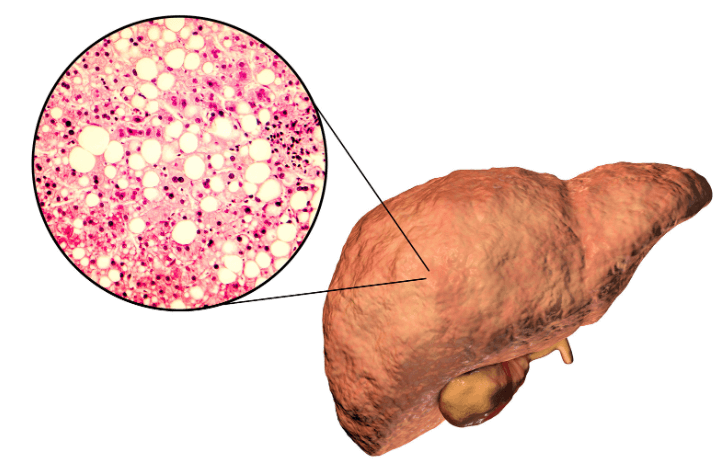Fatty liver disease, also known as hepatic steatosis, is a condition characterized by the accumulation of fat in the liver. This can lead to liver inflammation and impair the organ’s ability to function properly. Fatty liver disease can be caused by various factors, including obesity, high cholesterol, type 2 diabetes, and excessive alcohol consumption.
This article explores fatty liver disease, including its types, causes, and if can fatty liver be reversed. We’ll talk about the elements that influence reversal time, including lifestyle modifications and medication therapies.
What is Fatty Liver Disease?
Fatty liver disease is a metabolic illness in which fat accumulates in liver cells called hepatocytes. While some fat in the liver is acceptable, when it surpasses 5-10% of the liver’s weight, it is considered fatty liver disease. This disorder can vary in severity, from simple steatosis (fat accumulation) to non-alcoholic steatohepatitis (NASH), which causes inflammation and liver cell destruction. If untreated, fatty liver disease can lead to fibrosis, cirrhosis, and even liver failure.
There are two major types of fatty liver disease:
- Non-alcoholic fatty liver disease (NAFLD) is the most prevalent kind of fatty liver disease, accounting for approximately 80-90% of cases [1]. It is not directly related to excessive alcohol intake. Obesity, insulin resistance, type 2 diabetes, and metabolic syndrome all increase the risk of NAFLD.
- Alcoholic fatty liver disease (AFLD) is caused by consuming too much alcohol. Heavy alcohol consumption can harm liver cells and alter fat metabolism, resulting in fat buildup inside the liver.
Can Fatty Liver Disease Be Reversed Quickly
Unfortunately, there is no quick fix for reversing fatty liver disease. However, with the right lifestyle changes and medical management, it is possible to improve the condition over time.
How Long Does It Take To Reverse Fatty Liver?
The length of time it takes to reverse fatty liver disease depends on the severity of the condition and the lifestyle changes made by the individual. In some cases, it may take several months to a year to see improvements in liver health. However, with consistent effort and adherence to healthy habits, it is possible to reverse fatty liver disease over time. It’s important to work with a healthcare professional to develop a personalized plan for managing and reversing fatty liver disease.
What Factors Affect the Time to Reverse Fatty Liver?
Several factors can influence the time it takes to reverse fatty liver disease. These include:
- The type of fatty liver disease: The two primary kinds of fatty liver disease are non-alcoholic fatty liver disease (NAFLD) and alcoholic fatty liver disease (AFLD). Alcohol use does not induce NAFLD, but AFLD does. In general, NAFLD is simpler to reverse than AFLD, because AFLD recovery requires total abstinence from alcohol.
- Risk factors: Diabetes, high cholesterol, and metabolic syndrome can all impede the process of correcting fatty liver disease. Managing these underlying disorders is critical for maintaining normal liver function.
- Body weight: Excess body weight, especially obesity, can significantly prolong the time it takes to reverse fatty liver disease. Shedding extra pounds through lifestyle changes can expedite the process of improvement.
- The severity of the condition: The extent of fat accumulation and liver damage can impact the time it takes to reverse fatty liver disease. More severe cases may take longer to show improvement.
- Adherence to lifestyle changes: Consistently following a healthy diet, engaging in regular exercise, and maintaining a healthy weight are essential for reversing fatty liver disease. The level of commitment to these lifestyle changes can affect the speed of improvement.
- Underlying health conditions: Conditions such as obesity, type 2 diabetes, and high cholesterol can contribute to fatty liver disease. Managing these conditions through medication, diet, and lifestyle changes can influence the time it takes to reverse the disease.
- Alcohol consumption: Avoiding alcohol is critical for those with alcoholic fatty liver disease (alcohol related liver disease) to reverse the illness. Abstaining from alcohol can have a substantial influence on recovery time.
- Smoking: Smoking can worsen liver damage and inflammation. Quitting smoking can contribute to faster improvement in liver health.
- Genetic factors: Genetic predisposition can play a role in the development and reversal of fatty liver disease. Some individuals may have genetic factors that affect the rate of improvement.
- Overall health status: Factors such as overall health, immune function, and the presence of other medical conditions can influence the body’s ability to reverse fatty liver disease.
Diagnosis of Fatty Liver Disease
Fatty liver disease is frequently a quiet disorder, with no obvious signs. A doctor may suspect fatty liver disease based on your risk factors and conduct a physical examination. Blood tests can also be performed to evaluate liver function and identify abnormalities in liver enzymes.
Imaging studies, such as ultrasound or elastography, can also be performed to identify fatty liver disease and determine its severity.
Lifestyle Changes for Reversing Fatty Liver Disease
One of the most important steps in reversing fatty liver disease is adopting a healthy lifestyle. Here are some lifestyle changes that can help improve liver health:
Diet
A balanced diet that is low in saturated fats, sugars, and refined carbohydrates can help reduce fat accumulation in the liver. Eating plenty of fruits, vegetables, and whole grains is beneficial. It’s also important to limit or avoid processed foods, sugary drinks, and fried foods.
Exercise
Regular physical activity, such as brisk walking, cycling, or swimming, can help improve liver health and reduce fat in the liver. Aim for at least 30 minutes of moderate-intensity exercise most days of the week.
Weight loss
Losing weight, especially if you are overweight or obese, can help reduce fat accumulation in the liver. Even a modest weight loss of 5-10% can have a significant impact on liver health.
Alcohol
For those with alcoholic fatty liver disease, avoiding alcohol is crucial for reversing the condition. Even moderate alcohol consumption can worsen liver damage and inflammation.
Smoking
Smoking can also contribute to liver damage and inflammation. Quitting smoking can improve liver health and reduce the risk of liver disease.
Manage underlying conditions
If you have underlying conditions such as type 2 diabetes or high cholesterol, it’s important to manage them through medication and lifestyle changes. This can help improve liver health and reduce the risk of complications.
It’s important to work with a healthcare professional to develop a personalized plan for managing and reversing fatty liver disease. They can guide diet, exercise, and other lifestyle changes, as well as monitor your progress over time.
Conclusion
While there is no quick way to reverse fatty liver disease, making healthy lifestyle changes and seeking medical guidance can significantly improve the condition over time. It’s important to consult with a healthcare professional for personalized advice and treatment options.
If you enjoyed this article, you may also want to read this article on Warning Signs of Liver Problems You Shouldn’t Ignore.
*This information is not intended to serve as a substitute for professional medical or dietary advice tailored to individual needs.




